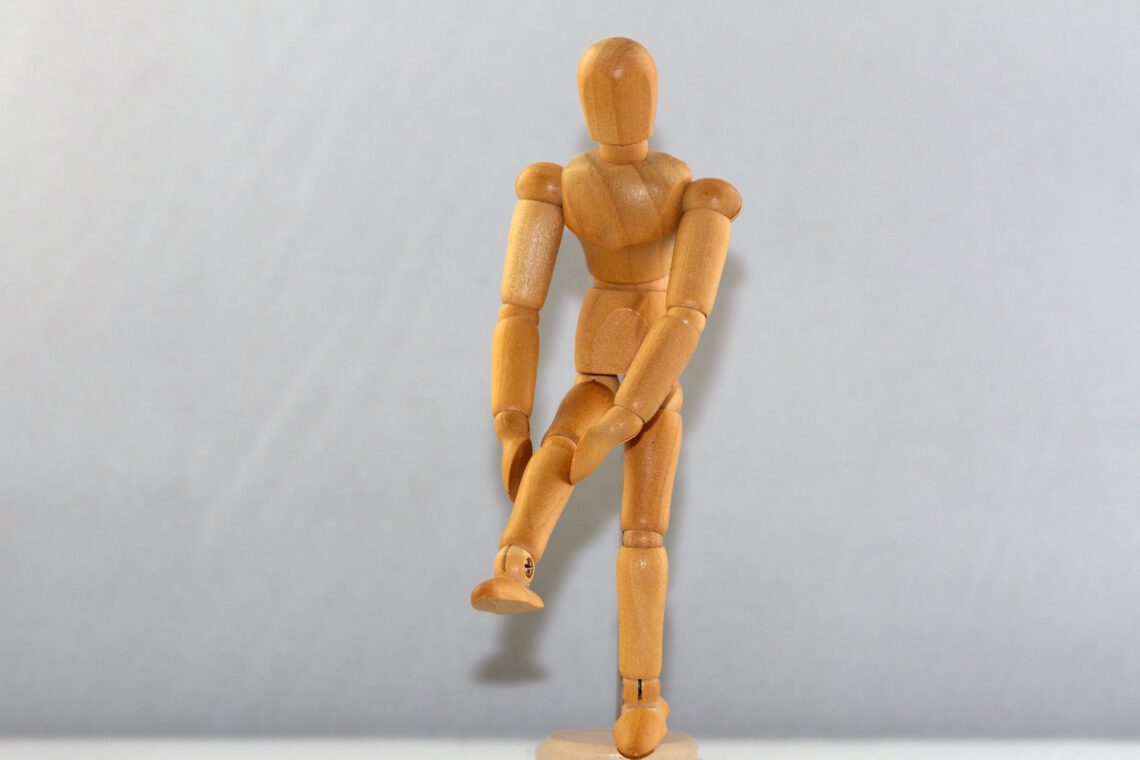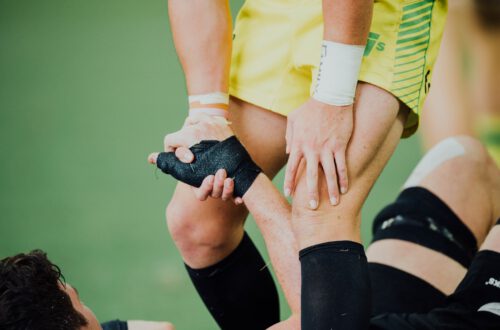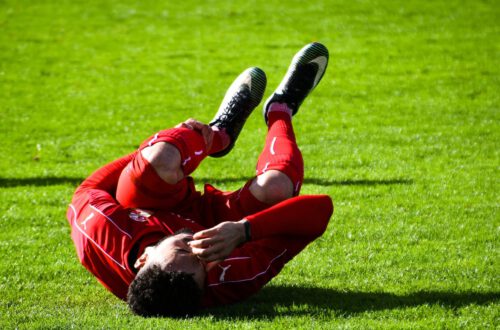
What type of strength training helps best against Patellofemoral pain syndrome (PFPS)?
Patellofemoral pain syndrome (PFPS) is a common condition. The condition is accompanied by pain and a decrease in physical functioning.
Strength training of the hip and knee muscles have a better effect in reducing pain and improving function compared to strength training of the knee muscles alone, in people with PFPS. We recommend to use strength training programs that include the hip and knee musculature.
Do you want to learn more about patellofemoral pain syndrome? Make sure to read this article to know what PFPS is about!
What is patellofemoral pain syndrome?
In this paragraph, we are going to explain a few things about what Patellofemoral pain syndrome (PFPS) is.
Firstly, PFPS is a common condition with an incidence of 22/1000. In other words 22 out of 1000 people will get it. In addition, women are 2 times more likely to develop PFPS.(1)
Moreover, PFPS is most common in adolescents and young adults. The condition is accompanied by pain and a decrease in physical functioning. These complaints can last for years(2) and in a number of cases the complaints persist.
In conclusion, PFPS is a condition involving pain in the front of the knee and is also known as anterior knee pain. The pain symptoms are expressed in and around the patella, but no structural changes in the knee are demonstrable.(3)
Pain is indicated in and behind the patella and is provoked by squatting, climbing stairs, running, sitting, and kneeling.(4) Pain leads to decrease in physical functioning.
What is the cause of patellofemoral pain syndrome?
In this paragraph, we tried to find the cause of PFPS in the literature that we gathered.

Nonetheless, not much is known about the possible cause of PFPS and the things known, are inconclusive. At first, it is suggested that PFPS can be caused by a disturbance in the load-carrying capacity of the soft tissues around the patellar femoral joint.
Also, people with overweight, previous trauma to the patellar femoral joint, or not optimal “tracking” of the patella due to morphological changes of the patella itself are all possible causes for PFPS.(5)
However, these possible causes of the PFPS are only hypotheses and substantiation as each possible cause is lacking to date. In light of all the ambiguity, it seems that the position of the hip joint influences the development of PFPS.(5)
In addition to the position of the hip joint, another suggestion is that pronation of the foot, increased adduction and internal rotation of the femur, in combination with weakened hip abductors, external rotators and extensors, may also be responsible for the development of PFPS.(6,7)
In the end, all suggestions have not led to more clarity about the possible cause of PFPS.
Strengthening the knee or the hip, what is the best?

We found multiple literature, with the statement of Nascimento et al.(8) best suited. It stated that additional strength training of the hip muscles has a positive effect on pain and functioning in people with PFPS.
In addition, strength training of the hip or knee musculature only appears in many cases to have a positive effect on pain, but not on functioning.
Furthermore, it makes no differences whether only the hip or knee musculature is trained.
In conclusion, despite the fact that the strength training programs have brought about little to no improvement in the degree of strength, the degree of pain and functioning have improved.
This supports the conclusion of Bolga et al.(9) that hip abduction strength is clinically not as important as previously thought.
We recommend to use strength training programs that include the hip and knee musculature.
Biomechanical view on the effect of strength training on the treatment of PFPS
In this paragraph we dive deeper into why strength training should work.
Firstly, let’s take a look at a biomechanical point of view. An imbalance of the pulling forces of the muscles that influence the position of the hip and knee causes the patella to be pulled more laterally.
In addition, due to the imbalance in (mechanical) forces, the patella cannot track properly in relation to the femur during flexion and extension activities of the knee. Therefore, local overloads occur in soft tissues such as capsule and ligaments that are innervated nocisensory.
Furthermore, in English literature this is also called “maltracking of the patella”. The m. gluteus medius and the m. tensor fascia latae (including the tractus illiotibialis) could play a role in this.(3,10)
Equally important, another biomechanical reason for not properly tracking the patella could be an imbalance between the distribution of forces of the m. vastus medialis and m. vastus lateralis.(11)
Before, various therapies from the past all have been based on different hypotheses. One of the examples of such therapy, is hip musculature training on strength, sometimes as monotherapy, but also in combination with strength training of the thigh musculature.
In conclusion, lately the systematic review of Nascimento et al.(8) was published, in which the effect of strength training on the hip muscles was studied in patients with PFP.
Based on the results of the systematic review, it was concluded that it is plausible that strength training of the hip and knee musculature can lead to a greater reduction in pain and improvement in function compared to strength training of the knee musculature alone.
Do you want to read more about knee rehabilitation? Make sure to read our article about blood flow restriction training and don’t forget to read our article about using an external focus in ACL rehabilitation.
Sources
- Boling M, Padua D, Marshall S, Guskiewicz K, Pyne S, Beutler A. Gender differences in the incidence and prevalence of patellofemoral pain syndrome. Scand J Med Sci Sports [Internet]. 2010 [cited 2017 Dec 3];20(5):725. Available from: https://www.ncbi.nlm.nih.gov/pmc/articles/PMC2895959/
- Blønd L, Hansen L. Patellofemoral pain syndrome in athletes: a 5.7-year retrospective follow-up study of 250 athletes. Acta Orthop Belg [Internet]. 1998 Dec [cited 2018 Feb 16];64(4):393–400. Available from: http://www.ncbi.nlm.nih.gov/pubmed/992254
- Petersen W, Ellermann A, Gösele-Koppenburg A, Best R, Rembitzki IV, Brüggemann G-P, et al. Patellofemoral pain syndrome. Knee Surg Sports Traumatol Arthrosc [Internet]. 2014 Oct [cited 2018 Feb 25];22(10):2264–74. Available from: http://www.ncbi.nlm.nih.gov/pubmed/24221245
- Cook C, Hegedus E, Hawkins R, Scovell F, Wyland D. Diagnostic Accuracy and Association to Disability of Clinical Test Findings Associated with Patellofemoral Pain Syndrome. Physiother Canada [Internet]. 2010 Jan 22 [cited 2018 Feb 13];62(1):17–24. Available from: http://utpjournals.press/doi/10.3138/physio.62.1.17
- McKenzie, K,. Galea, V., Wessel,J., Pierrynowski M. Lower Extremity Kinematics of Females With Patellofemoral Pain Syndrome While Stair Stepping. J Orthop Sport Phys Ther [Internet]. 2010 [cited 2018 Feb 16];40(10). Available from: https://www.jospt.org/doi/pdf/10.2519/jospt.2010.3185
- Lee TQ, Morris G, Csintalan RP. The Influence of Tibial and Femoral Rotation on Patellofemoral Contact Area and Pressure. J Orthop Sport Phys Ther [Internet]. 2003 Nov 1 [cited 2018 Feb 16];33(11):686–93. Available from: http://www.jospt.org/doi/10.2519/jospt.2003.33.11.686
- Souza, R, Powers CM. Differences in Hip Kinematics, Muscle Strength, and Mucsle Activation Between Subjects With and Without Patellofemoral Pain. J Orthop Sport Phys Ther [Internet]. 2009 [cited 2018 Feb 16];12(1). Available from: https://www.jospt.org/doi/pdf/10.2519/jospt.2009.2885
- Nascimento LR, Teixeira-Salmela LF, Souza RB, Resende RA. Hip and Knee Strengthening Is More Effective Than Knee Strengthening Alone for Reducing Pain and Improving Activity in Individuals With Patellofemoral Pain: A Systematic Review With Meta-analysis. J Orthop Sport Phys Ther [Internet]. 2018 Jan [cited 2018 Feb 18];48(1):19–31. Available from: http://www.jospt.org/doi/10.2519/jospt.2018.736
- Bolgla LA, Earl-Boehm J, Emery C, Hamstra-Wright K, Ferber R. PAIN, FUNCTION, AND STRENGTH OUTCOMES FOR MALES AND FEMALES WITH PATELLOFEMORAL PAIN WHO PARTICIPATE IN EITHER A HIP/CORE- OR KNEE-BASED REHABILITATION PROGRAM. Int J Sports Phys Ther [Internet]. 2016 Dec [cited 2018 Mar 15];11(6):926–35. Available from: http://www.ncbi.nlm.nih.gov/pubmed/27904794
- Waryasz GR, McDermott AY. Patellofemoral pain syndrome (PFPS): a systematic review of anatomy and potential risk factors. Dyn Med [Internet]. 2008 Jun 26 [cited 2018 Feb 25];7:9. Available from: http://www.ncbi.nlm.nih.gov/pubmed/18582383
- Kaya D, Doral MN, Callaghan M. How can we strengthen the quadriceps femoris in patients with patellofemoral pain syndrome? Muscles Ligaments Tendons J [Internet]. 2012 Jan [cited 2018 Feb 16];2(1):25–32. Available from: http://www.ncbi.nlm.nih.gov/pubmed/23738270




